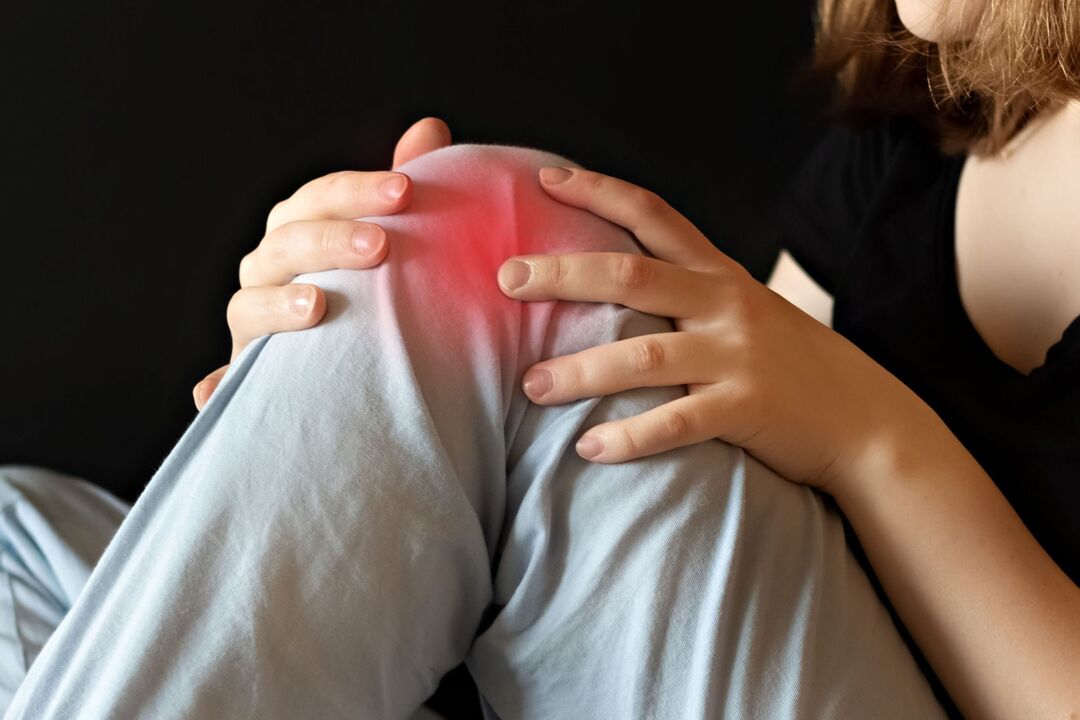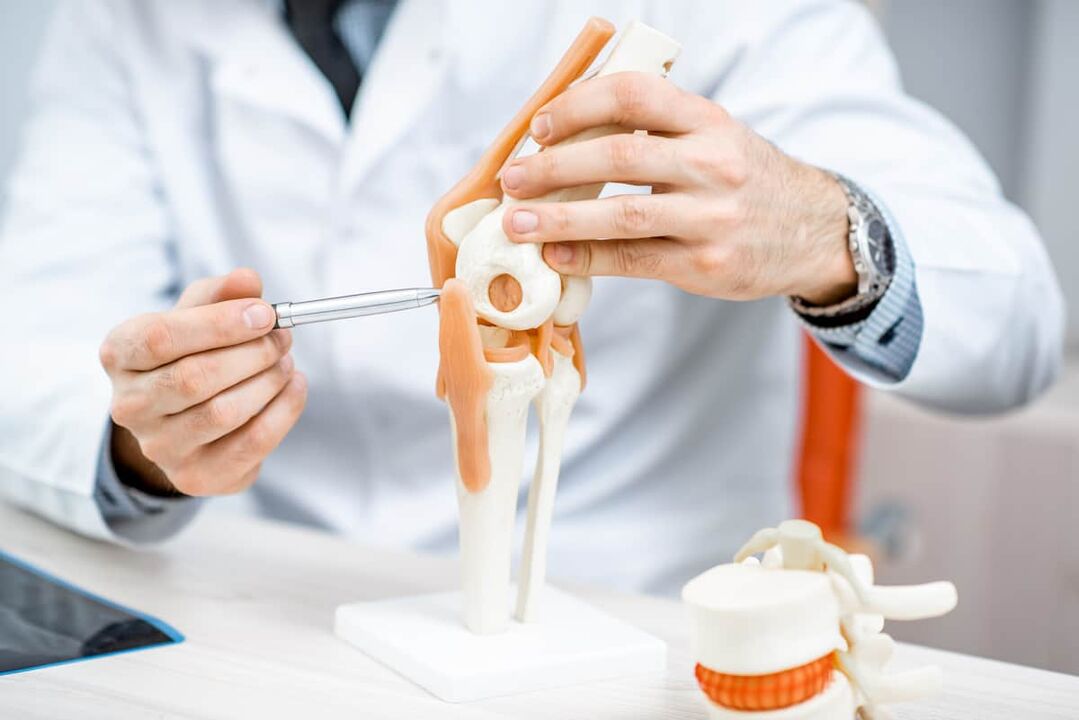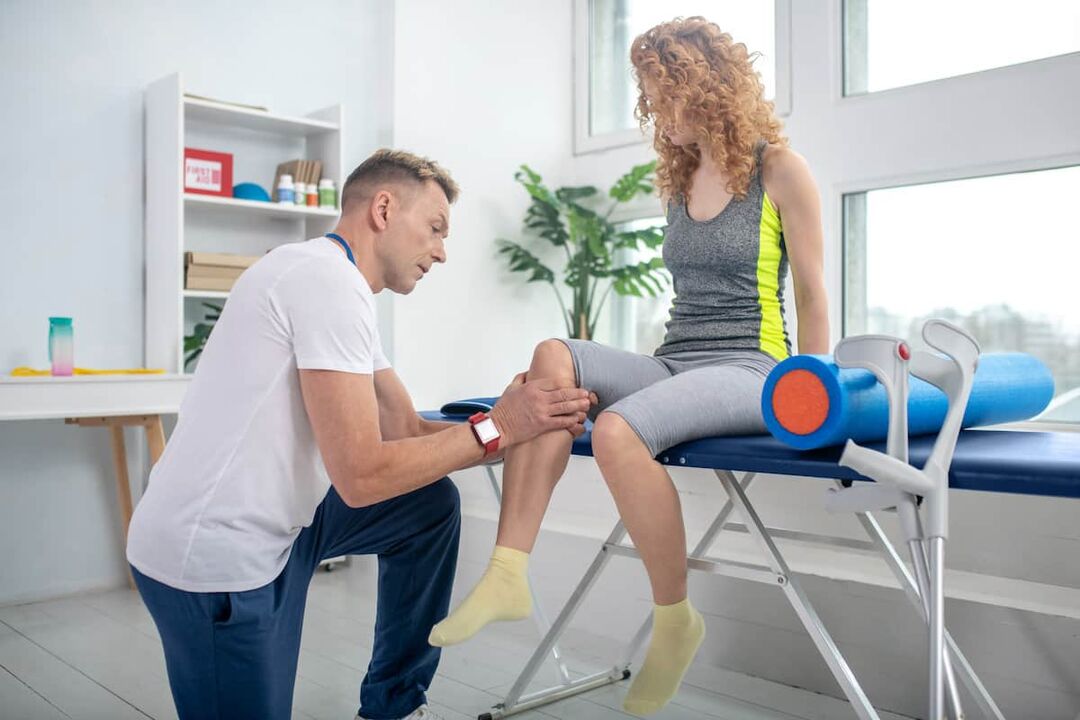
Knee pain occurs in patients of all ages and lifestyles. This pain is observed during physical activity for a variety of reasons: from injuries or bruises to significant illnesses and inflammations. Ignoring it can lead to serious consequences. A common question is what to do if you feel pain? At the first painful sensation, it is recommended to consult a doctor to avoid hospitalization; Treatment should only be carried out by a doctor.
The first manifestation of knee pain is usually caused by heavy loads, joint wear and tear and deformation. The disease is felt not only during excessive stress, but also during rest, while resting, and while carrying out everyday activities. In this article we will look at why the knee hurts, the main methods of diagnosis and treatment.
What is the knee joint?
The knee joint of our body supports a large load and body weight; is responsible for most injuries and stress during falls, sports and weight lifting. The knee joint itself is one of the largest in our body.
The knee joint includes:
- the joint itself;
- muscles;
- knee brace;
- menisci;
- joint capsule;
- ends of the femur and tibia,
- vessels,
- nerves,
- ligaments

Each of these components is susceptible to damage, although pain is not always felt immediately. For example, with a dislocated or torn meniscus and a torn anterior cruciate ligament, mobility will be reduced and vascular damage will cause a hematoma. Infection may begin in the knee joint capsule following infectious diseases. If the patient has a neurological disease, sharp pain in the knee may be felt. Furthermore, it can radiate to the joint with pain in the femur, tibia and muscles.
Causes of joint pain
The nature of pain can be divided into two groups: acute and chronic. Acute pain is characterized by progressive and rapidly developing pathologies. Chronic diseases, on the contrary, are quite slow and require lifelong treatment. The causes of this pain vary and so does the treatment.
Let's look at the main causes of pain.
Pain due to injuries
The cause of acute pain is injuries and various traumatic actions. You can get injured from a bad fall, playing sports, or uncomfortable shoes. Pain begins to be felt a few days after the injury. Generally, the knee presents a slight swelling and the victims feel quite tolerable pain. Depending on the severity of the injury, abrasions may occur on the surface of the skin. Furthermore, excess weight, abuse of bad habits and the peculiarities of the profession and work increase the risk of injury.
Types of injury:
- Knee injury.Frequent and light damage. Swelling and redness appear in the knee area and the surface temperature increases. Even a minor injury to the knee can cause the destruction of cells in the joint tissue.
- Sprains.Sometimes a muscle, ligament or tendon sprain goes unnoticed and causes stabbing, stabbing pain in the knee, and the joint itself becomes unstable when stepped on the leg.
- Ligament rupture.It can appear due to strong twisting of the leg in an unnatural direction and causes severe pain, swelling and swelling.
- Meniscus tear.It appears as a result of a heavy load, a blow to the knee, twisting of the leg and due to its unnatural position. A torn meniscus causes your legs to stop moving normally. It often occurs in athletes and is accompanied by swelling, bleeding and inability to bend the leg. There is a rule when it comes to sports: your knee may hurt, but it should go away the morning after training. If the disease does not go away, you need to see a doctor.
- Joint fracture.Due to the fracture, the soft tissues are also damaged, causing severe pain and deformation of the knee.
Unpleasant sensations in the knee are not always characterized by a disease in this department. Sometimes a herniated disc can cause knee pain at night. Discomfort can also occur if the knee joint is little used and the associated muscles lose tone.
The asymmetry of the sacrum and pelvic bones can also cause pain in the knee joint. It occurs as a result of a difference in the length of the lower extremities, which may be a consequence of congenital characteristics or curvature of the pelvis, including scoliosis.
Knee diseases
Any inflammation or damage to the structure of the knee causes discomfort, especially during movement. And the infection is not always localized to the knee itself. In general joint diseases, the entire body is affected and the knees become more damaged due to the great stress. Also, with injuries or diseases of the spine, or fracture of the femoral neck, pain in the knee joint may occur. Let's look at some of them:
- Arthritisis an inflammatory process that develops after trauma caused by an infection or metabolic problems. If left untreated, the cartilage in the knee joints continues to progressively wear away, leading to increased pain.
- Rheumatoid arthritis– an autoimmune disease in which the body's defense cells negatively affect tissues. The joint loses mobility, swelling appears, pain is constantly present and manifests itself in an increased sensation of stiffness.
- Rheumatism– as a rule, teenagers are susceptible to it, as are people who have recently had streptococcal diseases. Characterized by the alternation of unpleasant sensations.
- Gonarthrosis (arthrosis).It develops in one or both knees. This disease is characterized by the occurrence of degenerative dystrophic processes with growth of connective and bone tissue that interferes with movement. At the beginning of the disease, discomfort begins to be felt only after a long walk, but as the disease progresses, pain begins to appear even after walking short distances. It is difficult to get up from a chair, squat or climb stairs. Pain doesn't just bother you at rest. Destruction or thinning of shock-absorbing cartilaginous tissue occurs. As gonarthrosis develops, tightness in the knee and deformation of the joint are noted.
- Reactive arthritis– begins a few days after an intestinal infection. Severe pain combined with swelling and redness of the skin in the right or left knee often indicates reactive arthritis.
- Bursitis– inflammation of the joint capsule, causing severe pain and discomfort during movement.
- Periarthritis– inflammation of the tendons, muscles and ligaments surrounding the knee joint. Painful sensations appear with increasing load on the bent leg.
- Chondropathy– destruction of the cartilage that surrounds the knee joint and cushions friction and shock.
- Neoplasms– when they appear, the vessels become compressed and the joint capsule becomes deformed, causing pain and limiting mobility.
- Osteoporosis– tissues weaken, become more fragile, the calcium content in bones gradually decreases.
- Osteomyelitis– inflammation of the bone tissue appears in the affected area, accompanied by swelling, fever and sharp, intense pain.
- Osteoarthritis– the inflammation in the joint capsule gradually localizes to the heads of the bones. The cartilage wears down and becomes thinner, meaning that the heads of the bones no longer slide easily when moving the limb. Aching pain occurs.
- Osteoarthritis– a disease that affects all components of the joint.
- Patellofemoral pain syndrome– often occurs in young patients. During physical activity, the kneecap moves forward. This happens due to incorrect foot positioning, excessive and heavy loads with unprepared muscles.
- Osgood-Schlatter disease– knee pain when bending, climbing stairs, squatting.
- Nerve damage and nervous tissue disorders.Sharp pains, numbness and tingling appear in the lower limb and loss of mobility. A pinched nerve appears due to inflammation, neoplasms or previous injuries. Or neuritis develops - inflammation of the nerve in one or more areas. Severe pain is felt, mobility and sensitivity are reduced and the limb contracts involuntarily.
- Impaired blood supply.
- Various other infectious diseases.Complications that arise contribute to the appearance of weakness and pain.
In addition to the diseases listed, others can contribute to the onset of pain: synovitis, ligamentitis, tendonitis, gout, neuropathy, cysts and others.
Thus, knee pain is always a sign of a pathological process that affects the cartilaginous, bony or soft tissue structures of the knee itself, or of damage to the nerve that innervates it.
Diagnosis of knee pain

To begin treatment, it is necessary to establish an accurate diagnosis with a doctor at the clinic using diagnostic measures.
The patient seeks consultation with an osteopath, orthopedic traumatologist, surgeon or rheumatologist. If necessary, after examination and examination, the patient can be referred to another specialist.
During the consultation, the doctor collects an anamnesis – complaints, symptoms and problems that worry the patient, infections and chronic diseases. After that, the doctor can palpate the area in question and ask the patient to perform various movements and examinations. For example, bend and straighten your knee. This will provide initial information about the degree of discomfort.
To obtain additional information and determine an accurate diagnosis, the patient is referred for one or more tests:
- radiography (X-ray);
- ultrasound examination (ultrasound);
- magnetic resonance imaging (MRI) therapy;
- computed tomography (CT);
- arthroscopy (a special instrument, an endoscope, is inserted into the joint);
- puncture for collecting synovial fluid;
- laboratory tests (general and biochemical blood tests, serological tests).
To diagnose nervous diseases, MRI and CT are used, depending on contraindications. Some diagnoses require more precise tests.
To relieve knee pain, you can consult an osteopath, physical therapist, chiropractor, or massage therapist. An osteopath will help restore the normal position of the pelvic bones and internal organs, which has a positive effect on their functioning, improve the nutrition of all spinal structures, activating blood circulation and improve posture, eliminating deformities of the spine. spine.
Knee pain treatment
It is impossible to choose the best medicine for knee pain on your own. This is due to the fact that it is first necessary to find out the true cause of the symptoms and determine the type of pathological disorders in the body.
Knee joint treatment is carried out comprehensively. This set of measures includes:
- medicinal (non-steroidal anti-inflammatories or chondroprotectors - their effectiveness lies in preserving moisture in cartilage cells, inhibiting enzymatic action and interrupting the degenerative process);
- preparations, solutions for external use;
- osteopathy;
- carrying out special exercises and gymnastics, physiotherapy;
- physiotherapeutic techniques;
- massages;
- Vitamin complexes are medicines indicated to improve the body's metabolic processes.
Several types of physical therapy treatments can be used to treat musculoskeletal disorders that cause knee pain.
Physiotherapy classes are simple and accessible to people of any age, as an individually designed program guarantees the creation of an accurately dosed load. For complex therapy, local analgesics are also prescribed, for example, ointment with dimethyl sulfoxide (there are contraindications: serious diseases of the kidneys, liver, cardiovascular system, pregnancy, breastfeeding) or an anti-inflammatory gel - it is instantly absorbed into the skin, penetrates its deep layers, relieves swelling and pain.
Pain can also be eliminated with high-frequency techniques: the morphological changes remain, but the pain decreases and becomes easier. In addition, special orthoses are often prescribed - bandages, knee braces, splints, tapes, plaster casts and other similar devices. This allows you to transfer the load from the knee and unload it, reduce the risk of new injuries and promote rapid rehabilitation. Plasmolifting is rarely used - injections of plasma obtained from the patient's own blood directly into the affected knee joint or the soft tissues surrounding it.
Sometimes a bone realignment procedure or surgery is performed (for example, if bone fragments need to be removed).
The doctor also prescribes pain relievers that do not negatively affect the articular cartilage.
Pay attention to your diet – a balanced diet can prevent inflammation.
If you have knee problems, you should not self-medicate and undergo various procedures to avoid surgical intervention (operation) and possible complications. This attitude can only make the situation worse and more serious and complex therapy will be necessary. Therefore, it is important to consult a doctor who will establish an accurate diagnosis and prescribe competent treatments, procedures and medications that will have an effect. Take care of yourself and your health!























